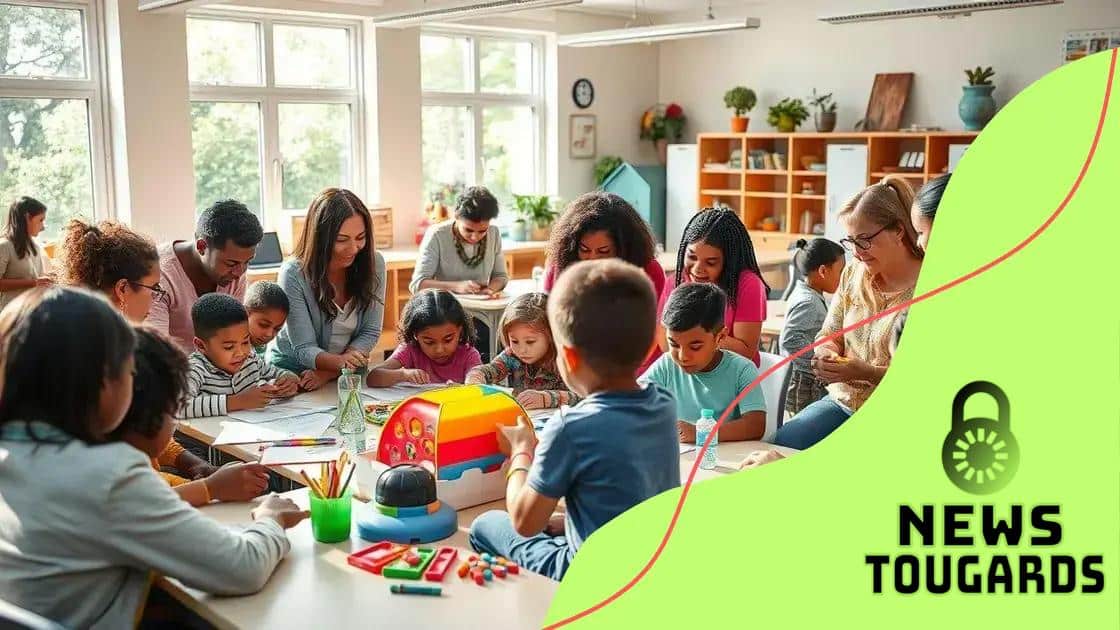Creating accessible and inclusive education through technology

Creating accessible and inclusive education through technology involves utilizing tools and strategies that cater to diverse learning needs, promoting equal opportunities for all students.
Creating accessible and inclusive education through technology is not just a trend; it’s a necessity. Imagine a classroom where every student, regardless of their background or ability, can thrive. Curious about how this can be achieved? Let’s dive in!
Understanding the importance of accessibility in education
Understanding the importance of accessibility in education is crucial for creating an inclusive environment for all learners. Every student deserves the chance to succeed, regardless of their abilities or backgrounds. By focusing on accessibility, educators can ensure that no one is left behind.
Why Accessibility Matters
Accessibility in education allows students with different needs to engage with learning materials fully. It enhances their educational experience and fosters a sense of belonging among all learners. When classrooms and resources are accessible, students feel valued and empowered.
Key Benefits of Accessible Education
- Encourages participation from all students.
- Promotes equal opportunities for learning.
- Supports diverse learning styles.
- Builds a more inclusive community.
Moreover, understanding the various aspects of accessibility can also lead to positive outcomes for teachers and institutions. It encourages them to innovate their teaching practices, making lessons more engaging and effective. When teachers are equipped with the right tools and strategies, they can help bridge the gap for students facing challenges.
Accessibility includes providing resources that cater to different needs, such as audio-visual aids, adapted materials, and assistive technologies. For instance, using screen readers or captioned videos can significantly enhance the learning experience for students with visual or hearing impairments.
Ultimately, prioritizing accessibility leads to better academic performance across the board. Students who feel included and supported are more likely to excel in their studies and continue their education beyond school.
Key technologies that support inclusive learning
Key technologies that support inclusive learning play an essential role in creating adaptable educational environments. These tools help to break down barriers for students with varying needs. From advanced software to innovative devices, each technology can make a significant difference in how content is delivered and absorbed.
Assistive Technologies
Assistive technologies are specifically designed to help students with disabilities engage more fully in their education. These tools can range from simple devices to complex software programs. Some common examples include:
- Screen readers that convert text to speech.
- Speech-to-text software that helps students write more easily.
- Electronic communication devices for students with speech impairments.
By implementing assistive technologies, educators create opportunities for every student to participate in learning activities. This approach not only increases accessibility but also empowers students with the tools they need to achieve their academic goals.
Digital Learning Platforms
Digital learning platforms also enhance inclusive education. These platforms can provide personalized learning experiences tailored to individual needs. For example, many platforms offer:
- Customizable content that adjusts to different learning styles.
- Multimedia resources that cater to various senses.
- Progress tracking features that help teachers support each student effectively.
Furthermore, these platforms often include collaboration tools that allow for real-time interaction between students and teachers, promoting engagement and inclusivity.
As education continues to evolve, integrating key technologies into the learning experience remains crucial. It allows educators to create a flexible learning environment that accommodates diverse needs, ensuring that all learners have the chance to succeed.
Strategies to implement inclusive practices in classrooms

Implementing inclusive practices in classrooms is essential for fostering a supportive learning environment. These strategies help ensure that all students, regardless of their abilities, feel welcomed and valued.
Inclusive Teaching Strategies
There are many effective strategies to use in the classroom. One important approach is differentiated instruction. This means tailoring lessons to meet the diverse needs of students. For example, teachers can use a variety of resources such as:
- Visual aids, like charts and videos, to support visual learners.
- Group work that encourages collaboration among students.
- Hands-on activities that engage kinesthetic learners.
Another effective method is creating a universal design for learning in the classroom. This framework allows for flexibility in teaching methods and assessments to accommodate individual learning differences. Providing multiple means of representation and engagement helps keep students interested and motivated.
Fostering a Positive Classroom Environment
Building a positive atmosphere is also crucial for inclusive practices. Teachers should encourage open communication among students. This creates a safe space where everyone can share their thoughts and feelings. Incorporating social-emotional learning into lessons can help students develop empathy and understanding for their peers.
Another strategy is to regularly seek feedback from students about their learning experiences. This can provide insight into what works best for them. Engaging with families and caregivers is equally important, as they can offer valuable perspectives on their children’s needs and strengths.
By utilizing these strategies, teachers can create a dynamic classroom environment where all students are empowered to learn and grow together. Emphasizing inclusivity not only benefits students with disabilities but enhances the learning experience for everyone.
Challenges in creating an inclusive educational environment
Creating an inclusive educational environment comes with its own set of challenges. While the goal of inclusivity is noble, various obstacles can impact the effectiveness of these efforts. Understanding these challenges is the first step toward addressing them.
Limited Resources
One major challenge is the lack of adequate resources. Many schools struggle to provide the necessary materials and technologies that support inclusive practices. This can include anything from assistive technology to training for staff on how to handle diverse learning needs.
Without these resources, it’s difficult to create a truly inclusive atmosphere. Additionally, schools may face budget constraints that limit their ability to invest in new tools and programs.
Staff Training and Awareness
Another significant hurdle is the need for professional development. Teachers and staff must be trained to understand the importance of inclusivity and how to implement inclusive techniques in their classrooms. This training is essential to foster an environment where all students feel valued.
Unfortunately, not all educators receive comprehensive training on inclusive education. As a result, they may feel unprepared to support students with varying needs effectively. This lack of confidence can lead to missed opportunities for student engagement.
Attitudinal Barriers
Attitudinal barriers can also impede the creation of an inclusive environment. Some educators and peers may hold preconceived notions about students with disabilities or learning differences. These stereotypes can create a negative atmosphere.
It is crucial to foster an environment of respect and understanding in schools. Raising awareness about the strengths and challenges of all students contributes to a more inclusive mindset.
By addressing these challenges head-on, educators and administrators can work toward creating a more welcoming and supportive educational environment for every student.
Future trends in accessible education technology
The future of accessible education technology is bright, with many trends emerging that promise to enhance learning experiences for all students. Technology continues to evolve, and the focus on creating inclusive learning environments is gaining momentum.
Personalized Learning Experiences
One significant trend is the growth of personalized learning. Technology is enabling educators to tailor lessons to meet individual student needs. This personalization can be achieved through adaptive learning software that adjusts the difficulty of tasks based on a student’s performance. As a result, every learner can progress at their own pace, ensuring that no one falls behind.
Artificial Intelligence in Education
Another exciting advancement is the integration of artificial intelligence (AI) in educational tools. AI can help analyze student data and offer insights into learning patterns. For example, AI can suggest resources and strategies that are best suited for each student. This technology can also automate administrative tasks, allowing teachers to focus more on individualized instruction.
Virtual and Augmented Reality
Virtual and augmented reality technologies are also set to change the way students engage with learning materials. These immersive experiences can make abstract concepts more tangible. For instance, students can explore historical sites or conduct virtual science experiments, providing deeper understanding and engagement.
As technology progresses, the development of more assistive tools is on the rise. Innovations such as text-to-speech and speech-to-text software are becoming more sophisticated and accurate. These tools help students with learning differences access content more easily, leveling the playing field in education.
Collaboration and Communication Tools
Future trends also encompass enhanced collaboration and communication tools that facilitate interaction among students, teachers, and families. Platforms that enable real-time collaboration allow students to work together, regardless of their location. This connectivity fosters a sense of community and supports diverse learning together.
By embracing these future trends, educators can create a more inclusive and accessible educational landscape that prepares students for success in a constantly evolving world.
FAQ – Frequently Asked Questions about Accessible Education Technology
What is the importance of accessibility in education?
Accessibility ensures that all students, regardless of their abilities, have equal access to learning opportunities.
How can technology support inclusive learning?
Technology such as assistive devices and adaptive software can meet diverse learning needs and enhance engagement.
What are some effective inclusive teaching strategies?
Strategies include differentiated instruction, collaborative learning, and using multiple means of representation.
What future trends should educators watch for?
Educators should look for trends like AI integration, personalized learning experiences, and advancements in virtual reality for education.





